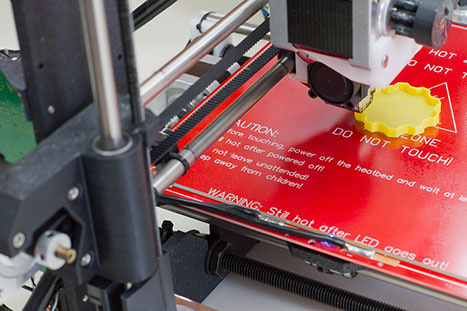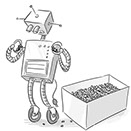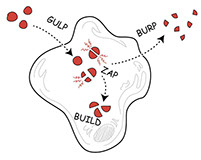SciGen Teacher Dashboard
Unit L5
The Sensational Single Cell
 Reading: Dr. Otto and the Four Fatal Flaws
Reading: Dr. Otto and the Four Fatal Flaws
Duration: Approximately 65 minutes
Join Dr. Otto as he builds cell-like robots that make copies of themselves in this illustrated story. The eight-part story provides a model of the four essential functions required of all cells. Those functions are: storing information and operating instructions, obtaining energy, acquiring building materials, and disposing of waste.
LEARNING OBJECTIVES
Students use the model of a robot to understand cell function. Learn any cell's four essential functions: storing and passing on operating instructions; obtaining energy; acquiring building materials; disposing of waste.
Students develop and use a model to describe the function of a cell as a whole system and begin to understand how the parts of cells contribute to the function.
Teacher Tips
- Decide if students will read individually or in pairs/groups, or if you will read the first two sections as a class.
- As of 2017 no self-replicating robots like those portrayed in the story have been developed, but there's been a lot of research around swarm robotics. See, for example, the Kilobots made at the Wyss Institute, or a video of them: Kilobots: A Thousand-Robot Swarm. Or the work of Daniela Rus at MIT.
Teacher Tune-ups
Teaching Notes
ACTIVITY OVERVIEW
- Introduce the model of autonomous, self-replicating robots (10 minutes)
- Read the story (35 minutes)
- Write, Turn and Talk (15 minutes)
- Wrap up (5 minutes)
Introduce the model of autonomous, self-replicating robots (10 minutes)
Read the story (35 minutes)
Students can read individually or in pairs/groups.
You may opt to start the reading as a whole-class activity, and then have the students read individually or in pairs/groups starting after the Turn and Talk in the second section, "The First Robot Prototype."
Paraphrase:
In the Science Scene, Tim compared real-life yeast cells to self-reproducing robots. Let's explore what a robot would need to be able to do to make copies of itself.
What can those imaginary robots show us about how living cells manage to make more and more copies of themselves? The story we'll read now explores the science fiction of self-reproducing robots, which someday may become science fact!
Dr. Otto and the Four Fatal Flaws
Part 1: Meet Otto, Mad Scientist
This is Dr. Otto, a mad scientist who runs a bakery.
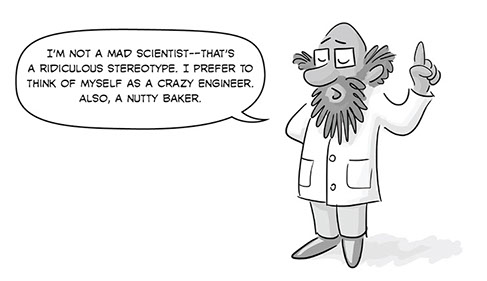
Um, okay, thanks for the clarification. Anyway, one day Dr. Otto is looking through his microscope at the baker’s yeast he uses in his bread, and he has an idea.
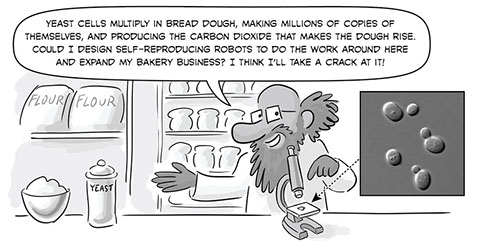
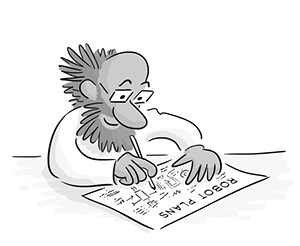 Dr. Otto draws up plans for a robot that can work in his bakery and that can also make copies of itself. He figures there are some basic abilities that both yeast cells and self-reproducing robots need to have in order to work and successfully reproduce themselves. He identifies four of these basic abilities. (What are they? You’ll see…) As he draws up his plans, Dr. Otto includes design features that give his robots these four abilities.
Dr. Otto draws up plans for a robot that can work in his bakery and that can also make copies of itself. He figures there are some basic abilities that both yeast cells and self-reproducing robots need to have in order to work and successfully reproduce themselves. He identifies four of these basic abilities. (What are they? You’ll see…) As he draws up his plans, Dr. Otto includes design features that give his robots these four abilities.
He sends his plans for his new self-reproducing robots across town to the Wild Fabrications Robot Factory. What could go wrong?
Part 2: The First Robot Prototype
A week later, Dr. Otto welcomes a shiny new robot to his bakery.

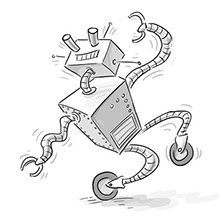 Dr. Otto nearly dances with joy as he takes the robot out of its box. He turns it on. Its battery has been partially charged at the factory, so it’s able to start right up!
Dr. Otto nearly dances with joy as he takes the robot out of its box. He turns it on. Its battery has been partially charged at the factory, so it’s able to start right up!
Robot A’s lights glow brightly, all sorts of mechanical noises come from inside it, it moves around—but soon, things begin to go wrong. The robot doesn’t behave with any purpose. Dr. Otto looks on in alarm as the robot just wobbles around randomly.
Upon close inspection, Dr. Otto notices that the robot factory overlooked a critical feature of his design. This mistake leaves out one of the basic abilities that both self-reproducing robots and yeast cells need.
 Turn and Talk
Turn and Talk
- Can you guess what critical ability Robot A is missing?
- What type of missing piece was overlooked at the factory?
Part 3: The Second Robot Prototype
Dr. Otto realizes that Robot A has no operating instructions, because the small computer with memory that was supposed be installed was left out.
Dr. Otto packs up the robot and sends it back to the Wild Fabrications Robot Factory.
A week later, Dr. Otto welcomes a second robot to his bakery.
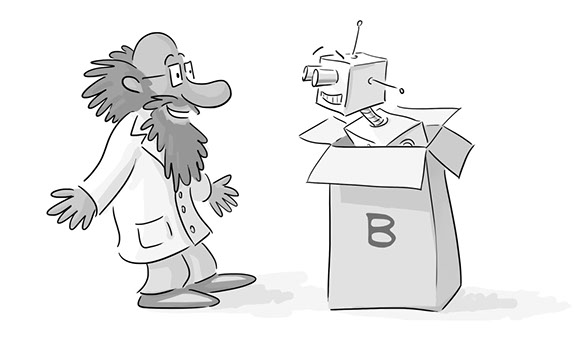
Once again, he takes it out of its box and turns it on.
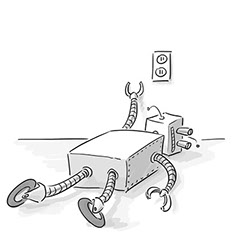 Robot B heads straight to an electrical outlet. But then it becomes confused. It looks from the outlet to Dr. Otto and back again. It looks down at itself and pats itself all over (clang, clang, clang!), like someone searching for something in a bunch of pockets. The Robot gradually slows down, and its lights go dim. Soon, it slumps to the floor and lies motionless.
Robot B heads straight to an electrical outlet. But then it becomes confused. It looks from the outlet to Dr. Otto and back again. It looks down at itself and pats itself all over (clang, clang, clang!), like someone searching for something in a bunch of pockets. The Robot gradually slows down, and its lights go dim. Soon, it slumps to the floor and lies motionless.
Examining the robot closely, Dr. Otto sees that the factory has again left out a necessary part of his design.
 Turn and Talk
Turn and Talk
- Can you guess what critical ability Robot B is missing?
- What type of missing piece was overlooked at the factory?
Part 4: The Third Robot Prototype
Dr. Otto checks the plans he sent to the factory. “There it is: there’s supposed to be an electrical cord for recharging the robot,” he says, “but the factory forgot to put it in.” So Robot B lacks the ability to acquire energy that it needs to keep operating. Dr. Otto packs the robot up and sends it back to the Wild Fabrications Robot Factory.
A week later, a third robot is delivered to his bakery.
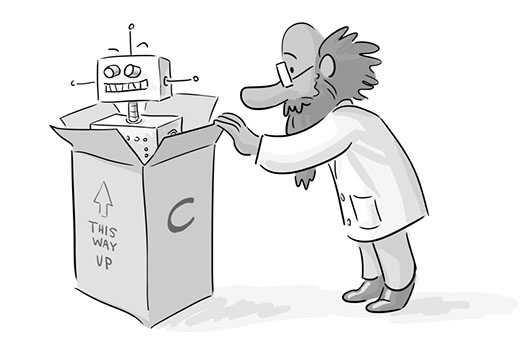
Dr. Otto is excited to try out Robot C, although by now he’s a little nervous. Once again, he takes it out of its box and turns it on.
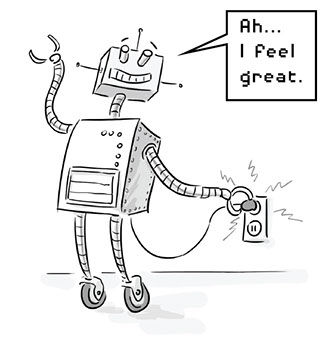
Robot C looks great at first. It goes to an electrical outlet and uses a built-in electrical cord to plug itself in. After getting charged up, it unplugs itself.
Robot C goes over to a pile of raw materials that Dr. Otto has provided for his robots to use when making copies of themselves—scrap metal, recyclable plastic, silicon-rich sand and other substances. But the Robot can’t take in the raw materials. The Robot scoops them up and holds them, but then it just looks confused.
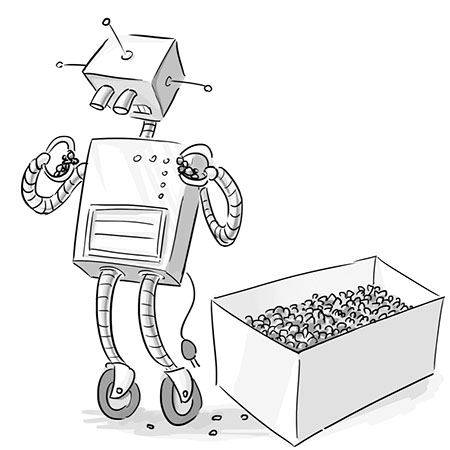
“Oh dear,” sighs Dr. Otto. “It’s happened again. The factory has left out another important feature of my design.”
 Turn and Talk
Turn and Talk
What do both self-replicating robots and yeast cells need to be able to do that Robot C can’t do? What type of missing piece did the factory forget to build into the robot?
Part 5: The Fourth Robot Prototype
Dr. Otto realizes that the robot factory overlooked the part of his plans where he had drawn an intake opening to allow the robot to take in materials. The robot needs to be able to bring in materials to repair itself and build new robots. He packs up Robot C and sends it back to the Wild Fabrications Robot Factory, with the relevant part of the plans circled.
A week later, a fourth robot arrives at the bakery.

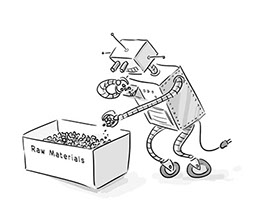 Anxious but hopeful, Dr. Otto takes the robot out of its box. This one has a materials-intake opening: check! Dr. Otto turns it on. But once again, things start out right and then go wrong.
Anxious but hopeful, Dr. Otto takes the robot out of its box. This one has a materials-intake opening: check! Dr. Otto turns it on. But once again, things start out right and then go wrong.
Robot D picks up some raw materials and pours them into its intake opening. Soon it has taken in the whole supply of raw materials.
Then strange noises come from inside it—grinding, burning, gurgling, and hammering noises—while its internal machinery turns the useful elements of the raw materials into new robot parts. Those parts start coming out of Robot D like candy coming out of a snack machine, and the robot starts to put some of them together to make a new robot.
But something isn’t right.
Robot D is starting to swell up. Its metal sides groan, and its rivets start to pop out at the seams. Before it can finish building a complete copy of itself, it bursts open. Unusable materials—gaseous, liquid, and solid—pour out of the ruptured robot.
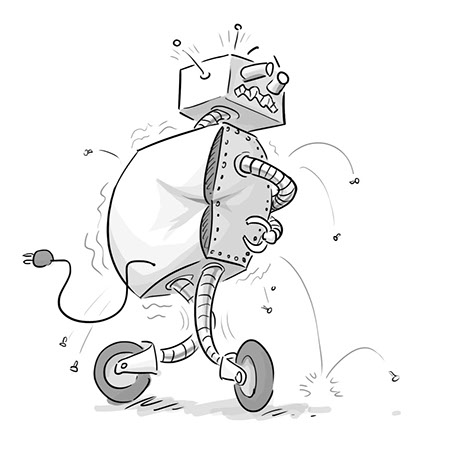
For the fourth time, Dr. Otto examines the robot wreckage and figures out what important feature of his design the factory forgot to include.
 Turn and Talk
Turn and Talk
Can you guess what critical ability Robot D is missing? What type of missing piece was overlooked at the factory?
Part 6: The Fifth Robot Prototype
Dr. Otto looks at the plans that he sent to the Wild Fabrications Robot Factory and realizes that his drawings and notes could have been clearer. The factory missed the part where he showed how the robot would remove waste materials that have not been turned into new robots. Dr. Otto highlights the section on the plan where the robot fabricators should include waste output pipes.
Dr. Otto packs the fourth robot up and sends it back to the Wild Fabrications Robot Factory.
A week later, a delivery truck rolls up to the bakery with a fifth robot.

“Please work!” Dr. Otto begs as he takes the robot out of its box and turns it on.
Robot E has an electrical cord and successfully charges up its batteries. It scoops raw materials into its intake opening, and its internal machinery starts turning the useful elements of the raw materials into new robot parts. This time it has a way to remove materials wasted while building robot parts.
The robot assembles a copy of itself using the new parts it has made.
“Now how about baking some bread?” Dr. Otto suggests.
“You got it doc,” say the two robots together.

Part 7: The Robots’ First Work Day
First the two robots take in raw materials so that they can start making new robot parts internally. Then, while their insides are churning away, they get to work baking bread. Dr. Otto beams with pride. “This is great! As long as my robots can repair and reproduce themselves faster than they break down, I’ll be able to stay in business forever.”
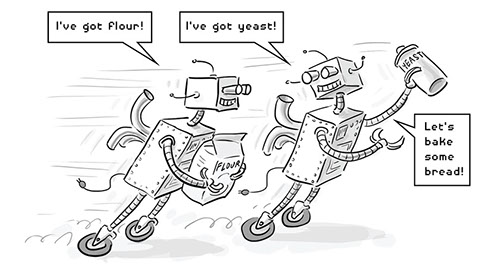
At the end of the day and thousands of loaves later, the robots look worn and tired. Fortunately, they’ve been generating parts to repair themselves and to build new copies of themselves.
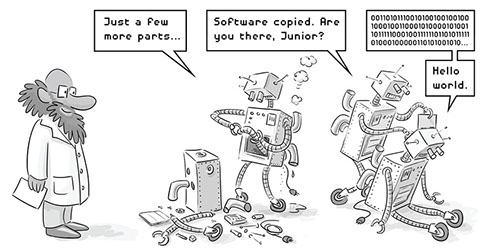
Each robot builds a copy of itself. Then all four robots plug into electrical outlets to charge their batteries overnight.
Part 8: Persistence Pays Off
The next morning, the four robots take in raw materials to start generating new robot parts. Then they start baking more bread.
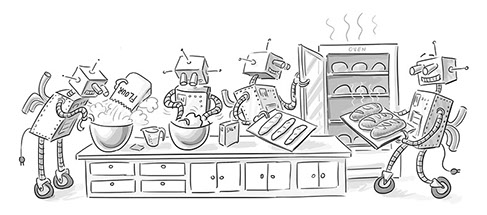
“Well,” says Dr. Otto, “four different things went wrong. But I fixed them, and now I have a team of Dr. Otto’s Baker Bots making enough bread to feed the entire town. Tonight I’ll have eight robots. Tomorrow night, sixteen! Soon, I’ll be able to feed the whole county, the state, and then the world!”
He stops and scratches his head. “Hmm… I’m going to need more flour. And more yeast. Maybe more ovens, and an upgraded electrical system with more outlets for more robots to recharge their batteries. And I need to get a hold of more raw materials for the robots to use. I better get to work.”
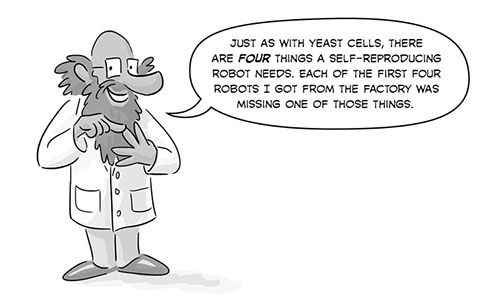
Write, Turn and Talk (15 minutes)
With a partner, list the one thing that you think was missing from each defective robot, starting with the first robot prototype.
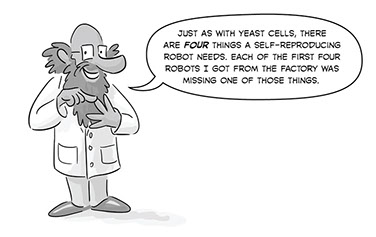
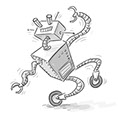
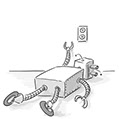
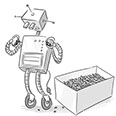
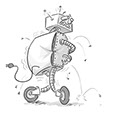
You should have four different defects in all.
- The First Robot Prototype had no operating instructions.
- The Second Robot Prototype robot could not get energy.
- The Third Robot Prototype could not obtain building materials.
- The Fourth Robot Prototype could not dispose of waste.
Wrap up (5 minutes)
BETA Version - Please send comments and corrections to info@serpinstitute.org
